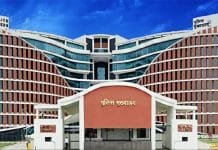Book Review : The Historical Evolution of the District Collector – From Early Days to 1947 by Dr. C.K.Mathew
– V.SRINIVAS, IAS –
Dr. C.K.Mathew has embarked on a 5 volume work on District Collector., the first volume of which has been published titled “The Historical Evolution of the District Collector – From Early Days to 1947”. This volume traces the transformation of the District Collector being an agent of the British East India Company to occupying the position of the primary field officer at the District level duly empowered by the Raj and now to an all-purpose administrator in present day India functioning as the face of Government. Dr. C.K.Mathew is eminently qualified to undertake “The Historic Evolution of the District Collector” having served 37 years in the IAS and as a District Collector in 2 districts of Rajasthan, in Barmer and Bhilwara. In Rajasthan the District Officer is the mai-baap, accepted by all as the head of administration and the first port of call in times of crisis, and his leadership can make a difference between mediocrity and excellence.
The book is divided into 16 chapters.
It begins with a quote from K.K.Das, report on reorganization of Collectorates, Government of UP said “There is not and never has been an official like the Collector, anywhere else.” There is a quote from David C.Potter that says “….the head of the district administration appeared to preside over people from a great height,.. concerned to ensure the maintenance of the rules…” Dr. C.K.Mathew explains that the elite nature of the Service to which the District Officer belongs is being transformed so that the Service can represent more equitably the complex nature of Indian society.
The chapter Thoughts on Colony and Empire: The District Officer’s Role in Theory deals with the role of the District Collector in the British Empire embodied the Indian Civil Service, presenting an irresistible force that brooked no opposition from zamindars or local chiefs. The British believed that wrongs could be righted and stability imposed to halt exploitation of people at the hands of the local tyrants and landlords through the District Collector by bringing the universal principles of fair play and justice. Post 1857, the Company’s Civil Service was replaced by the British Government’s Officers through competition and selection. Their ethics were qualitatively different from the officers of the company, while displaying impartiality and a superior sense of service. India was to be guided by law, statute and regulation even as the need to protect imperial interests remained paramount. Even during the 2 World Wars and the freedom movement, the District Collectors kept the vast country in order – forever minutely just and inflexibly straight.
The chapterDistrict Administration before the advent of the British in the Mauryan, Mughal and Sultanate systems of District Administration deals with similar institutions that preceded the British Raj. The subahdars were the equivalent of District Collector. The subahdars were appointed from Mughal Princes or the officers holding the highest mansabs. The nuts and bolts of revenue administration was put in place by Sher Shah Suri who introduced the Qabuliyat system to formalize the agreement between the farmer and the government. In Mughal period, civil servants were expected to visit the Mughal court regularly and their advancement was dependent on their attending the court and the value of gifts presented to the emperor.
It is the British period that remains the centrality of the book. The chapters Arrival of the British and India under the East India Company deal with the period when the British East India company became the largest commercial enterprise and secured a greater share of India’s export business than rivals Dutch, Danish, Portugese and French trading companies. The East India Company’s victory in the Battle of Plassey made clear to every Indian where the actual power lay. Thereafter the East India Company wrested control of all of North Eastern India and 250 clerks of the Company with 20,000 Sepoys ran the finances of India’s 3 richest provinces of Bengal, Bihar and Orissa. The British appointed their own District Officers for assessment and collection of revenue and administer justice and conduct all functions of government. The Company became the colonial corporate State and officers indulged in plunder. Despite some honorable exceptions, most of the officials were corrupt. Perhaps the company’s meagre salaries ensured such corruption. The Company did push for adequate subsistence to curb corruption.
The chapter Evolution of Revenue Administrationstarts with the Company administering the revenue affairs of 41 villages, collectively called Calcutta. The first 3 Districts administered by the Company were Burdwan, Midnapore and Chittagong. The early experiments of the Company resulted in much of the Company’s profits being pocketed by Naib Dewans. The Select Committee of the Company concluded that English Officers had to be placed in-charge of the District. It was in 1769 that the Company appointed the first British Officers in-charge of the Districts. The District Collector was born in 1772 by an official order of Lord Warren Hastings. To the English Officers, the British sense of justice and compassion became important. Judicial reforms followed laying down code of regulations/ code of procedures for courts. Collectors were called District Magistrate and Collector. The District Judge bereft of Magisterial duties was known as the District and Sessions Judge. By 1787, there were 35 Districts under the Company and the District Collector was formally installed as the Chief Administrator of the District, a responsibility that continues to hold today 230 years later. British India at its peak had 250 Districts each of which were divided into 3-4 Sub-Divisions and split into Tehsils.
The chapter District Officer at the Intersection Between Empire, Land and Citizen deals with the Permanent Settlement of Bengal – the Zamindari and the Ryotwari systems. The collection of revenue became the bed rock of the British architecture of governance. The work of the District Collector involved a knowledge of village life, of the various land tenures and of the general outlook of rural areas. The District Officer engendered respect and shouldered responsibility and once the Crown took over the administration of India, the Civil Service continued to maintain its standard of integrity and efficiency due to its mature exercise of responsibility.
The chapter District Administration and Ground Realities deals with the expansion of the Collector’s responsibilities from Revenue work to Magisterial duties, the establishment of the Office of the Collector. The prestige and the influence of the District Officer emanated from 2 features of district organization – thecontrol over Tehsildars and Village Servants and the leadership of all the Departmental services. The Collector’s offices were handled by senior staff and he was left to carry out supervision and inspection.
The chapter Indian Civil Service and the Role of the District Collector deals with the structure of the imperial government. In 1922, the Prime Minister Lloyd George described the British Civil Service as the steel frame (1200 Officials to administer a population of 350 million) which should be strengthened and as the institution that built up the British Raj. The appointments to the ICS was under the Government of India Act 1858 and carried the weight of authority under the provisions of the Act as a covenanted service. Salary and pension were established and promotion was on the principle of seniority.
In 1831, the Magisterial functions of Judges were transferred to District Collectors making the Collector the chief executive officer of the regulation provinces. He took an active role in suppressing crime with the assistance of District Superintendent of Police. The civil service retained the confidence of the people by their neutral stance and apolitical firmness. The view that an impartial officer could restore order and maintain the routine tasks of administration and redressal of public grievances. The conditions of life and service were hard but the civil servants had the satisfaction of knowing that their toil had not been in vain. The first Indian to join the Indian Civil Service was Satyendranath Tagore, and in 1871 three more joined including SurendranathBanerjea. The Indianization of the Indian Civil Service increased after the World War I as there was a significant shortage in British recruitment – 40 percent by direct recruitment from British, 40 percent by direct recruitment from Indian and 15 percent by promotion from provincial civil service.
The chapter District Officer’s Role During War and the Struggle for Independence deals with the testing times faced by the District Officer in times of war, both First and the Second World Wars, as well as the civil disturbances that preceded the granting of independence in 1947. It was a test of quality and enforcement as the State turned into a security state with primary focus on law and order. There was agricultural distress and industrial unrest. Religious and communal tensions were witnessed. It was a period when the politician stood forth as the mediator and there was a perceptible decline in the role of the District Officer. For an Indian in the ICS there was no scope for any personal feelings of patriotism or support for national fervor. In the years between 1935 and 1947 many British ICS officers left service, and after 1947 there was a large-scale exodus of British Officers to England. The British Officers were offered a retirement with pension and a lump sum for loss of career.
The chapter Empire and the District Officer – Different Points of View highlights the dichotomy that prevailed in the context on the impact of the working of the District Officer. Will Durant has highlighted the deliberate and conscious bleeding of India by England for 150 years. The objective was to make the Indian nation subservient in every possible way. Dalrymple and Tharoor describe the Company’s activities in India as a supreme act of corporate violence. There are accounts of the District Officer upholding the ideals of good governance, law and order and compassion to the peasants. Critics also have highlighted the ICS’s exclusiveness, lack of mental adaptability, caution and complacency. At the same time officers of the service were praised for their devotion to duty, efficiency, incorruptibility and impartiality.
A thoroughly enjoyable read
____________________
The book reviewer :  is an IAS officer of 1989 batch, currently serves as Additional Secretary to Government of India and Director General of National Centre for Good Governance.
is an IAS officer of 1989 batch, currently serves as Additional Secretary to Government of India and Director General of National Centre for Good Governance.
He is an author of 2 books, “India’s Relations with the International Monetary Fund 1991-2016 – 25 years in Perspective” and “Towards a New India – Governance Transformed 2014-2019”. V.Srinivas is a senior civil servant, an academician and institution builder par excellence.
published by Azim Premji University 2020 – 248 pages
















